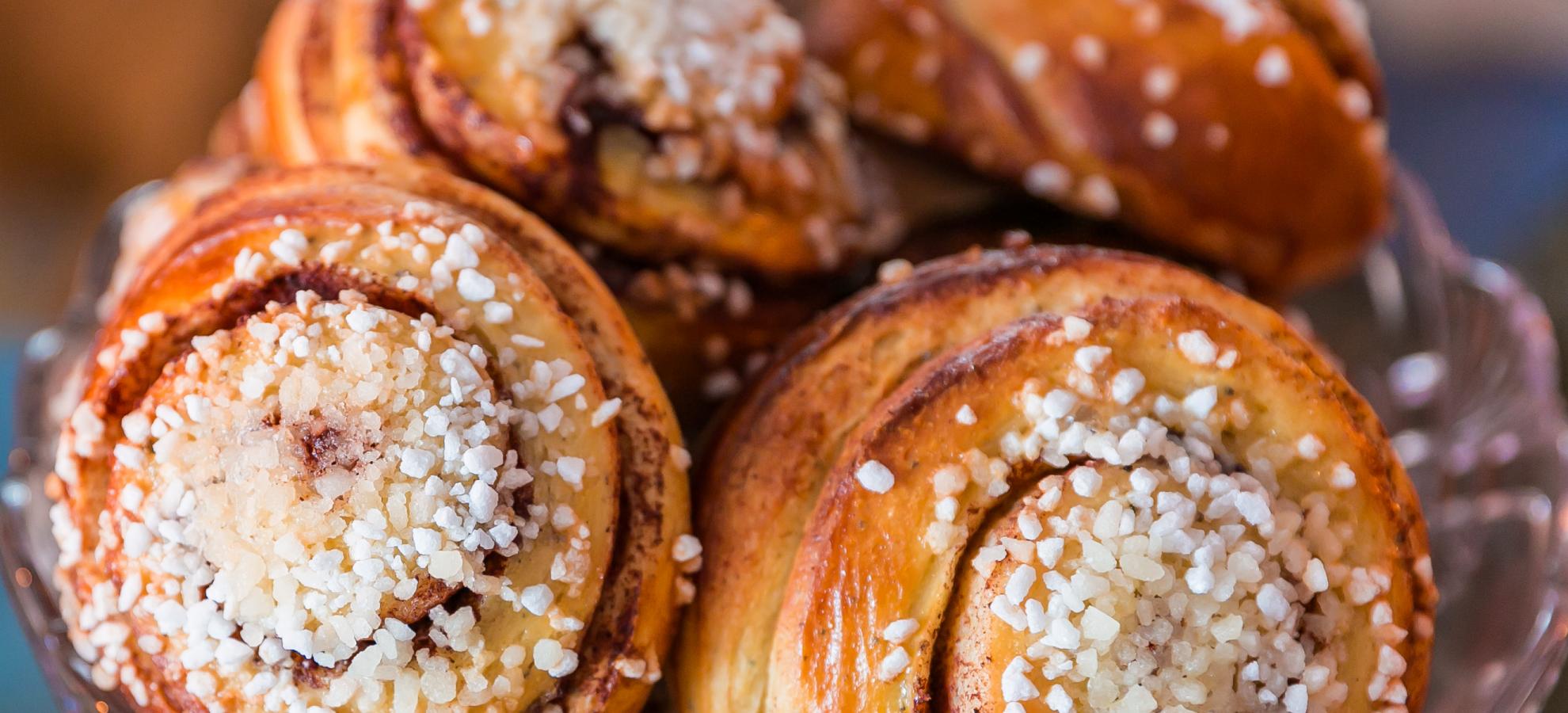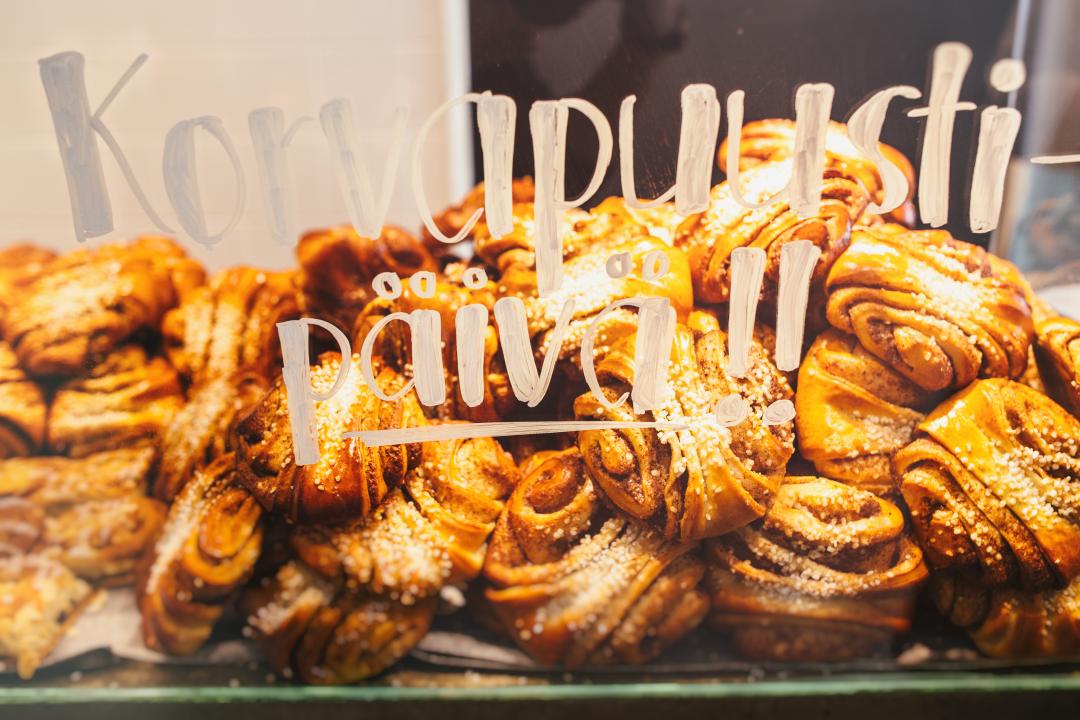
Every morning the sweet scent of cinnamon, sugar and butter fills the streets of Helsinki. The mouthwatering smell comes from the local version of the cinnamon bun known as a “korvapuusti”. Even though Finns generally eat savoury food for breakfast at home, when they go out to a café they nearly always order a cinnamon bun with their coffee.
The reverence for this sweet cinnamon laced bun is so strong that there is a day dedicated to this delicacy. Every year on 4 October people celebrate this delicious bun with gusto.
There is an art to appreciating the perfect korvapuusti that can take a lifetime to master. First examine the surface of your cinnamon bun. It should have many shades of brown, from dark espresso to light latte in colour. If the colour is to uniform, there could be reason to suspect that it has been industrially manufactured. Cinnamon buns should definitely look and taste as if they were home baked.
The perfect korvapuusti should be sprinkled with thick granules of pearl sugar and never with fine sugar. The layers of the bun should also open up easily, revealing the beautiful cinnamon inside.
And there should be a lot of cinnamon!
The perfect korvapuusti should be sprinkled with thick granules of pearl sugar and never with fine sugar. The layers of the bun should also open up easily, revealing the beautiful cinnamon inside.
Although the amount of sugar and butter that has been used cannot be seen with the naked eye, at least this insulates us from the truth that cinnamon buns are not exactly health food. And neither should they be. I’ve never heard a Finn asking – or being told – how many calories there are in a korvapuusti. That would be sacrilege!
Unlike many other traditional sweet pastries in Finland, cinnamon buns are baked and consumed all year round and on a daily basis. At the start of the year from January to 5 February we eat Runeberg tarts (Runebergin torttu), small cakes that are flavoured with almonds and arrack or rum. They are named after our national poet Johan Ludvig Runeberg, who is said to have enjoyed tarts made by his wife Fredrika dipped in punch.
Around Shrove Tuesday in February or early March, a variation of the sweet bun known as a laskiaispulla is served. These sweet buns are cut in half and filled with thick cream and jam or marzipan. Finns love to debate which of the two is the proper filling. Although Shrove Tuesday comes just once a year, laskiaispulla can be enjoyed throughout February – they are too good to resist!
On the last day of April and the First of May, the traditional “Vappu” holiday, Finns eat sugar donuts and a type of deep-fried funnel cake known as tippaleipä. The latter could be distantly related to Spanish churros, except we Finns don’t dip ours in chocolate.
Throughout December we eat star-shaped Christmas tarts known as joulutorttuja. These are made from puff pastry and filled with prune jam. On 13 December, Swedish-speaking Finns in particular celebrate Lucia Day by eating a special type of sweet bun known as Lucia-kierrepulla or “lussekatten” in Swedish.
But cinnamon buns are eaten all year round!

The idea of socialising over pullas and coffee is deeply ingrained in the Finnish identity. With a cinnamon bun in one hand and a cup of coffee in the other the locals will resolve their work problems and matters of the heart, celebrate the first warm days of the summer and the birth of a child, and commiserate over having to return to work after the holidays. Cinnamon buns are comfort food, but also joy and power food. The korvapuusti is a sweet bun of goodwill, and offering one to another person is a token of love.
In the good old days Saturday was “Sweet Bun Day” in Finland, a day when mothers and daughters – not so much the men – baked pullas and korvapuustis. Those who baked the best cinnamon buns were unlikely to divulge their secret recipes, but everyone tried to make theirs as sticky, elastic and soft as possible. The trick is to use as little flour as possible and to let the dough rise to double its size. After the dough has been rolled and cut and shaped, the dough is allowed to rise even more before it is put in the oven.
In recent years Finnish cinnamon buns have taken on all kinds of surprising shapes. Some creative bakers have even twisted theirs to resemble tiny wreaths. The question is, when is a korvapuusti no longer a korvapuusti…
Once the cinnamon buns have been baked to a golden brown, they are placed in a basket covered by a linen towel. By the way, no one in Finland refers to them as “cinnamon buns” (kanelipulla) – they are specifically known as korvapuusti, which translates roughly as “ear pulla”.
Don’t be surprised if the salesperson in the café or bakery asks you to point to the exact korvapuusti that you want; it’s common knowledge in Finland that some people like theirs dark, others light. There are even some who only eat the soft middle!
By the way, if you feel uncomfortable sitting by yourself in a café, just order a korvapuusti. Everyone understands a person who has been enticed to come in off the street by the smell of fresh-baked cinnamon buns!
